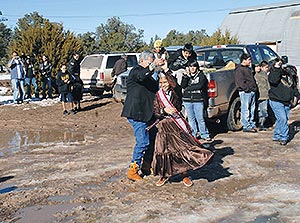Pine Springs residents anticipate paved road
By Chee Brossy
Navajo Times
PINE SPRINGS, Ariz., Jan. 8, 2009

(Times photo - Paul Natonabah)
Jackie Yazzie Jr. swings his partner Kelly Yazzie, the reigning Miss Wide Ruins, despite mud and snow, during a meeting to celebrate an expected project to pave the Pine Springs Road Monday at Pine Springs, Ariz. The two were dancing to the 9010 Dirt Road Band.
Community members saw a familiar face at the Jan. 2 groundbreaking ceremony to pave Navajo Route 9010, better known as Pine Springs Road.
Many of the elders in attendance remembered Norman Ashcroft, the last trader to run the old Pine Springs Trading Post.
It's been over 30 years since Ashcroft closed the trading post and moved to Continental Divide, N.M., but he found some things were still the same.
"I was coming up here this morning on old Pine Springs Road and there it was - all the old slush and mud," Ashcroft said. "I said, 'Lord, you better enjoy this, I hope this is the last time we see it like this.'"
The road has never been paved but it is the main thoroughfare here, basically connecting the community, situated on the Defiance Plateau, to the developed world. The road goes south for 11 miles, eventually connecting with Interstate 40 near Houck, Ariz.
To the north it connects with Navajo Route 28, which goes to Oak Springs, where the chapter house is seated. Here, 13 miles from Pine Springs, the road joins Navajo Route 12, where the pavement resumes.
Route 28 is considerably rockier than the Pine Springs Road and dips through a canyon and climbs over rough terrain. There currently are no plans to pave it.
Ashcroft remembered that in the '60s, when he was a trader in Pine Springs, people were talking about trying to get a paved road built.
Austin Sam, a community member and advocate for paving the road, said local people voiced the need for a new road even earlier.
"They were talking about a new road in the '40s and '50s, but nothing happened," Sam said.
Although the groundbreaking has been held, construction will not begin on the road until spring or summer and not all the right-of-way agreements have been signed.
Community members said they were encouraged to hold the ceremony now to draw attention to the need for improvements at their most urgent - in the winter.
The BIA Navajo Region Department of Transportation must obtain all the needed right-of-way agreements before starting construction, said Irvin Bekis, regional road engineer.
When construction does begin, the $15 million project will take about a year and a half to complete, Bekis said.
The road can get bad, especially when a heavy snow pack begins to melt. Then it can become impassable for school buses, and people have trouble just getting in and out of their homes for supplies and groceries. The mud makes it difficult to transport sick or injured people to the hospital.
Ashcroft told of a woman undergoing a difficult childbirth who had to be airlifted out by helicopter during one especially bad winter. The roads were basically impassable, he said.
During the day of the groundbreaking, conditions were as bad as ever, with the sun melting the previous week's snowfall in no time, turning the road into a muddy quagmire, especially at the higher elevation of Pine Springs proper.
You needed a vehicle equipped with four-wheel drive or a truck with weight in the back to get through the sticky patches, and even then your vehicle would slide all over the road.
Some residents note that Pine Springs has lost some of its population to relocation as a result of the difficult access.
"We've lost a lot of the elderlies to nursing homes. It's hard to care for them out here in the winter time - you need wood, and you have to haul water," said Ashem Dayea, 47. "Many of the elderlies use small, economically sized vehicles and those are harder to get around in here when the roads are bad."
Talk of fixing the road got serious when then Congressman Rick Renzi, R-Ariz., visited early in the decade and then sought federal funding to pave it.
Since then the project has been on the priority list of the Navajo Nation Council's Transportation and Community Development Committee.
Now at the top of the list, with all the preliminary engineering and surveys completed, the project looks to be on track for completion.
But obtaining rights of way is not always easy, and the road traverses checkerboard territory - meaning allotment, private and fee land holders all must give their OKs, not to mention the grazing permit holders on tribal land.
But Pine Springs residents are hopeful, and if their attitude at the Jan. 2 ceremony is any indication, very happy that a paved road is in the works.
"There was an old wagon trail that used to go from Ganado to Houck," said Francis Burnside, 66. "We used to say that it would be the main highway in the time to come. Covered wagons pulled by teams used to come through on it.
"Now we have the reality in N-9010 and this is really appreciated by the community," he added. "Not one person is really responsible for this - everyone put in their work to make it happen."
Seeing no road yet, Ashcroft was a bit more wary in his outlook.
"In '67 they were talking about a new road," he said. "Good thing I came back; it jogged my mind real quick when I hit the mud."

